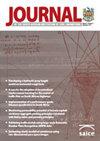Application of a modern laser technique to evaluate the performance of recycled railway ballast
IF 0.6
4区 工程技术
Q4 ENGINEERING, CIVIL
Journal of the South African Institution of Civil Engineering
Pub Date : 2022-12-13
DOI:10.17159/2309-8775/2022/v64n4a2
引用次数: 0
Abstract
The performance of railway track structure is influenced by the ballast shape properties including roundness, flatness, elongation, sphericity, angularity and surface texture. The challenge is how to accurately measure the irregular shapes of ballast materials and directly link them to performance. In this paper, a modern three-dimensional laser technique was used to determine shapes of freshly produced crushed ballast and recycled ballast sampled from the heavy-haul coal line in South Africa. The objective was to investigate the effect of ballast shapes on settlement (i.e. permanent deformation). All five ballast materials were scanned in the three-dimensional laser scanning system and the data collected was processed to reconstruct three-dimensional models of the ballast particles. The results obtained were used to develop a chart to classify ballast shapes and link these shapes physically with settlement determined from a triaxial testing programme. Based on the triaxial test results, new empirical models were developed to determine settlement on the route corridor of the heavy-haul coal line. It is anticipated that outcomes of this study would assist with quality assessments and railway ballast maintenance in the field.现代激光技术在铁路回用镇流器性能评价中的应用
轨道结构的性能受道碴形状特性的影响,包括圆度、平整度、伸长率、球度、棱角度和表面纹理。挑战在于如何准确测量压载材料的不规则形状,并将其与性能直接联系起来。在本文中,使用现代三维激光技术来确定从南非重载煤生产线取样的新生产的碎碴和回收碴的形状。目的是研究道碴形状对沉降(即永久变形)的影响。在三维激光扫描系统中对所有五种压载材料进行扫描,并对收集的数据进行处理以重建压载颗粒的三维模型。所获得的结果用于绘制一张图表,对道碴形状进行分类,并将这些形状与三轴试验程序确定的沉降进行物理联系。基于三轴试验结果,建立了新的经验模型来确定重载运煤线路走廊上的沉降。预计这项研究的结果将有助于现场的质量评估和铁路道碴维护。
本文章由计算机程序翻译,如有差异,请以英文原文为准。
求助全文
约1分钟内获得全文
求助全文
来源期刊
CiteScore
0.70
自引率
25.00%
发文量
19
审稿时长
>12 weeks
期刊介绍:
The Journal of the South African Institution of Civil Engineering publishes peer reviewed papers on all aspects of Civil Engineering relevant to Africa. It is an open access, ISI accredited journal, providing authoritative information not only on current developments, but also – through its back issues – giving access to data on established practices and the construction of existing infrastructure. It is published quarterly and is controlled by a Journal Editorial Panel.
The forerunner of the South African Institution of Civil Engineering was established in 1903 as a learned society aiming to develop technology and to share knowledge for the development of the day. The minutes of the proceedings of the then Cape Society of Civil Engineers mainly contained technical papers presented at the Society''s meetings. Since then, and throughout its long history, during which time it has undergone several name changes, the organisation has continued to publish technical papers in its monthly publication (magazine), until 1993 when it created a separate journal for the publication of technical papers.

 求助内容:
求助内容: 应助结果提醒方式:
应助结果提醒方式:


